PaaS Vendor Comparison: Top 7 Platforms 2024
Looking for the best Platform-as-a-Service (PaaS) provider in 2024? Here's a quick rundown of the top 7:
- AWS Elastic Beanstalk: Best for language variety
- Microsoft Azure: Ideal for enterprise
- Google App Engine: Great for serverless
- Engine Yard: Perfect for Ruby on Rails
- Heroku: Suited for startups
- IBM Cloud: Tailored for large organizations
- Red Hat OpenShift: Excellent for multi-cloud setups
Related video from YouTube
Quick Comparison
| Platform | Best For | Key Feature | Main Drawback |
|---|---|---|---|
| AWS Elastic Beanstalk | Language variety | 175+ services | Complex pricing |
| Microsoft Azure | Enterprise | Strong security | Needs expertise |
| Google App Engine | Serverless | AI insights | Smaller market share |
| Engine Yard | Ruby on Rails | Managed DevOps | Limited languages |
| Heroku | Startups | Container-based | Pricey at scale |
| IBM Cloud | Large orgs | Hybrid options | Complex for newbies |
| Red Hat OpenShift | Multi-cloud | Kubernetes-based | Steep learning curve |
When picking a PaaS, consider:
- Your app's needs
- Budget constraints
- Growth potential
- Support quality
- Security requirements
- Innovation opportunities
The PaaS market is set to hit $176 billion by 2024. Choose wisely to stay ahead in this booming industry.
AWS Elastic Beanstalk
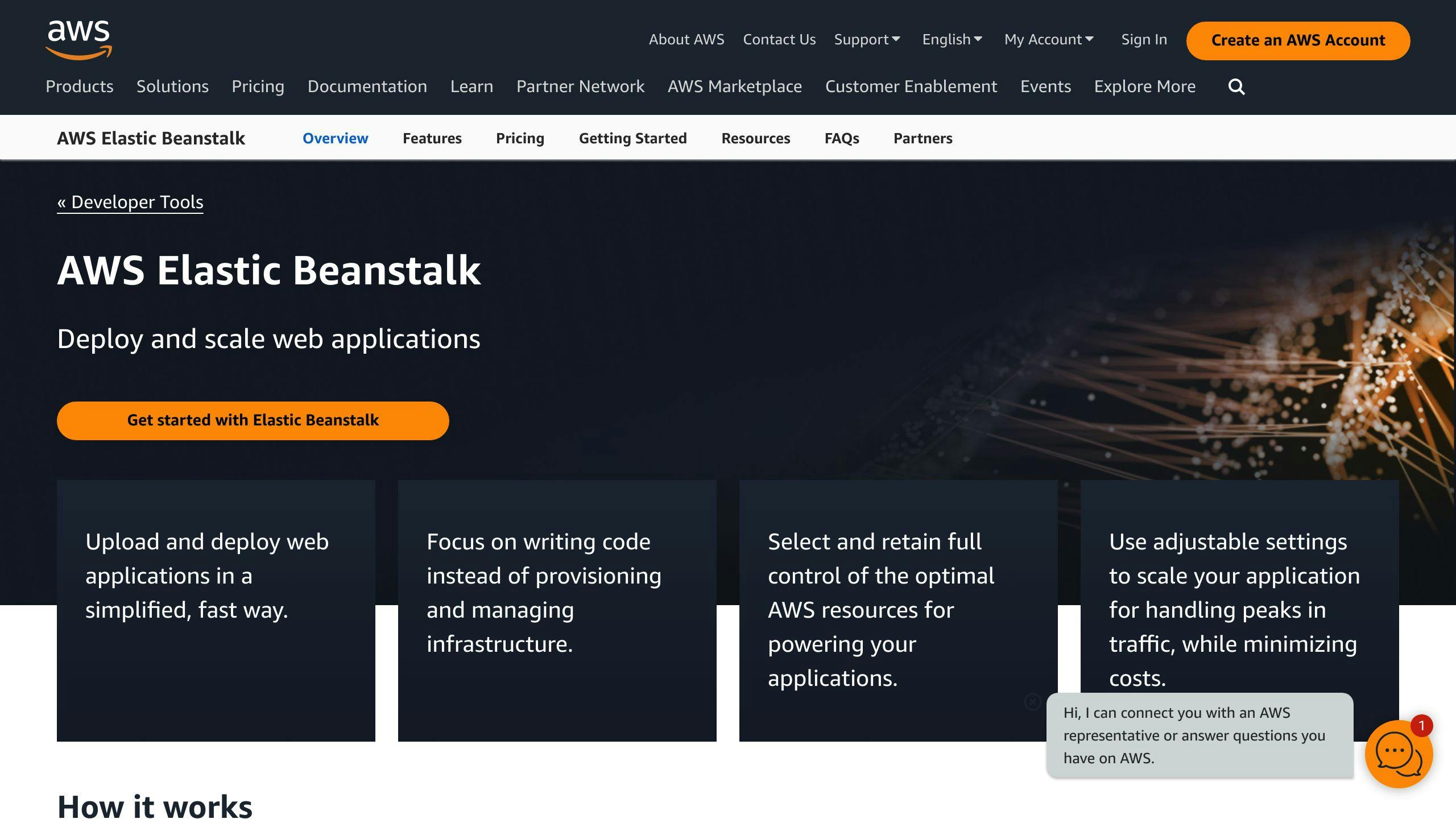
AWS Elastic Beanstalk takes the hassle out of deploying and scaling web apps. It's like having a personal IT team that handles all the boring infrastructure stuff, so you can focus on what matters: writing killer code.
What's Cool About It?
- Set It and Forget It: Upload your code, and Elastic Beanstalk does the rest. It's like a Crockpot for your app.
- Polyglot Paradise: Supports Java, .NET, PHP, Node.js, Python, Ruby, Go, and Docker. Pick your poison.
- Plays Well with Others: Easily connects to other AWS services like S3, SNS, and CloudWatch.
- Oops Button: Multiple versions and easy rollbacks. Because we all make mistakes.
Language Buffet
Elastic Beanstalk's got you covered, no matter your flavor:
| Language/Platform | Versions |
|---|---|
| Java | Multiple JDKs |
| .NET | Framework and Core |
| PHP | Various |
| Node.js | Multiple |
| Python | 2.x and 3.x |
| Ruby | Multiple |
| Go | 1.x |
| Docker | Custom images |
Show Me the Money
Here's the kicker: Elastic Beanstalk itself is FREE. You only pay for the AWS resources you use:
| What You Use | What You Pay For |
|---|---|
| EC2 Instances | Type, size, and how long you run 'em |
| RDS Instances | Type and storage |
| S3 Storage | How much you store |
| Data Transfer | Outbound data |
| Load Balancer | If you use it |
Want to keep costs down? Try these:
- Pick the right instance types
- Set up auto-scaling
- Use Spot Instances for non-production
Scaling: Small to XXL
Elastic Beanstalk's got options:
- Auto Scaling: Like pants that grow with you
- Manual Scaling: For control freaks
- Scheduled Scaling: Plan for those traffic spikes
But hey, it's not all rainbows and unicorns. Some devs find it limiting for complex stuff. One user called it a "bad wrapper over EC2" with a "bad deployment model." If you're doing advanced wizardry, you might want to check out ECS with Fargate or Kubernetes (EKS in AWS).
2. Google App Engine
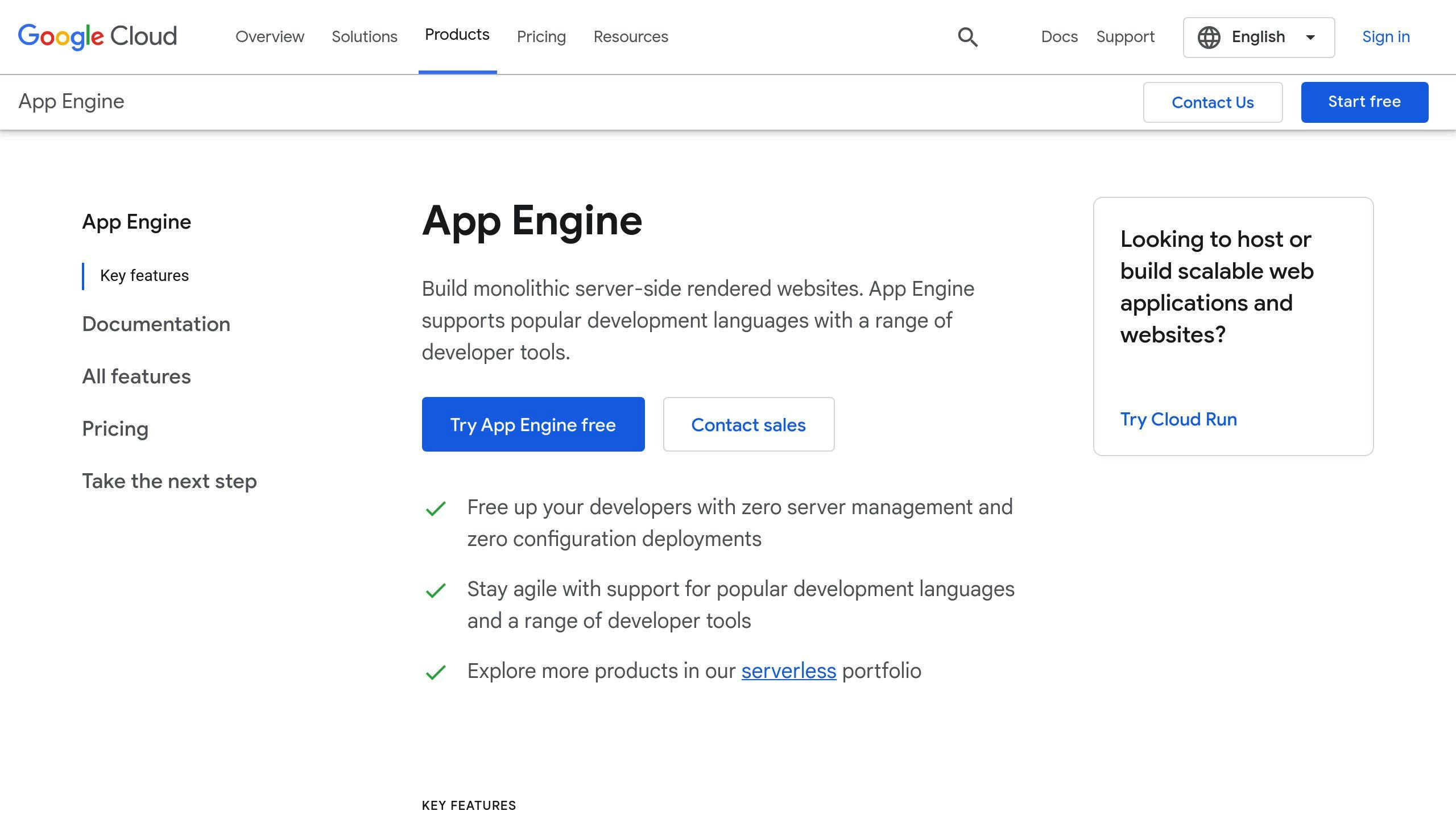
Google App Engine (GAE) is a serverless platform that handles infrastructure management for you. It's like having a personal IT team working 24/7.
Main Features
- Auto-scales your app
- Balances load across servers
- Simplifies deployment
- Integrates with other Google Cloud services
- Allows traffic splitting for testing
- Includes built-in monitoring
Languages Supported
GAE speaks many languages:
| Language | Environment |
|---|---|
| Python | Standard & Flexible |
| Java | Standard & Flexible |
| Node.js | Standard & Flexible |
| Go | Standard & Flexible |
| PHP | Standard & Flexible |
| Ruby | Standard & Flexible |
| .NET | Flexible |
| Custom | Flexible (via Docker) |
Pricing
You pay for what you use. Here's a quick look:
Standard Environment:
| Instance Class | Cost per Hour |
|---|---|
| B1 (basic) | $0.05 |
| F1 (frontend) | $0.05 |
| B4 (basic) | $0.20 |
| F4 (frontend) | $0.20 |
Flexible Environment:
| Resource | Unit Cost |
|---|---|
| vCPU | $0.0526/hour |
| Memory | $0.0071/GB/hour |
There's a free tier for the Standard Environment: 28 instance hours per day.
Scaling Options
- Automatic: GAE handles everything
- Basic: You set instance count
- Manual: You control instance count
User Opinions
GAE's convenience comes at a price:
"Google App Engine is expensive in the long run and cost adds up pretty quickly. Since it is fully managed and serverless … that needs a lot of compute, memory and network resources since it is expensive, being fully management and serverless." - Verified User, Analyst in Information Technology
But it can be budget-friendly for some:
"Extremely low cost option for web page deployment. It so simple to prototype or even offer a … better off moving to the Flexible environment (which may be a little more expensive but certainly a little…" - Tristan Dobbs, Vice President of Shared Services
Big names like Snapchat, YouTube, and Khan Academy use GAE. It's about finding the right fit for your project and budget.
3. Microsoft Azure
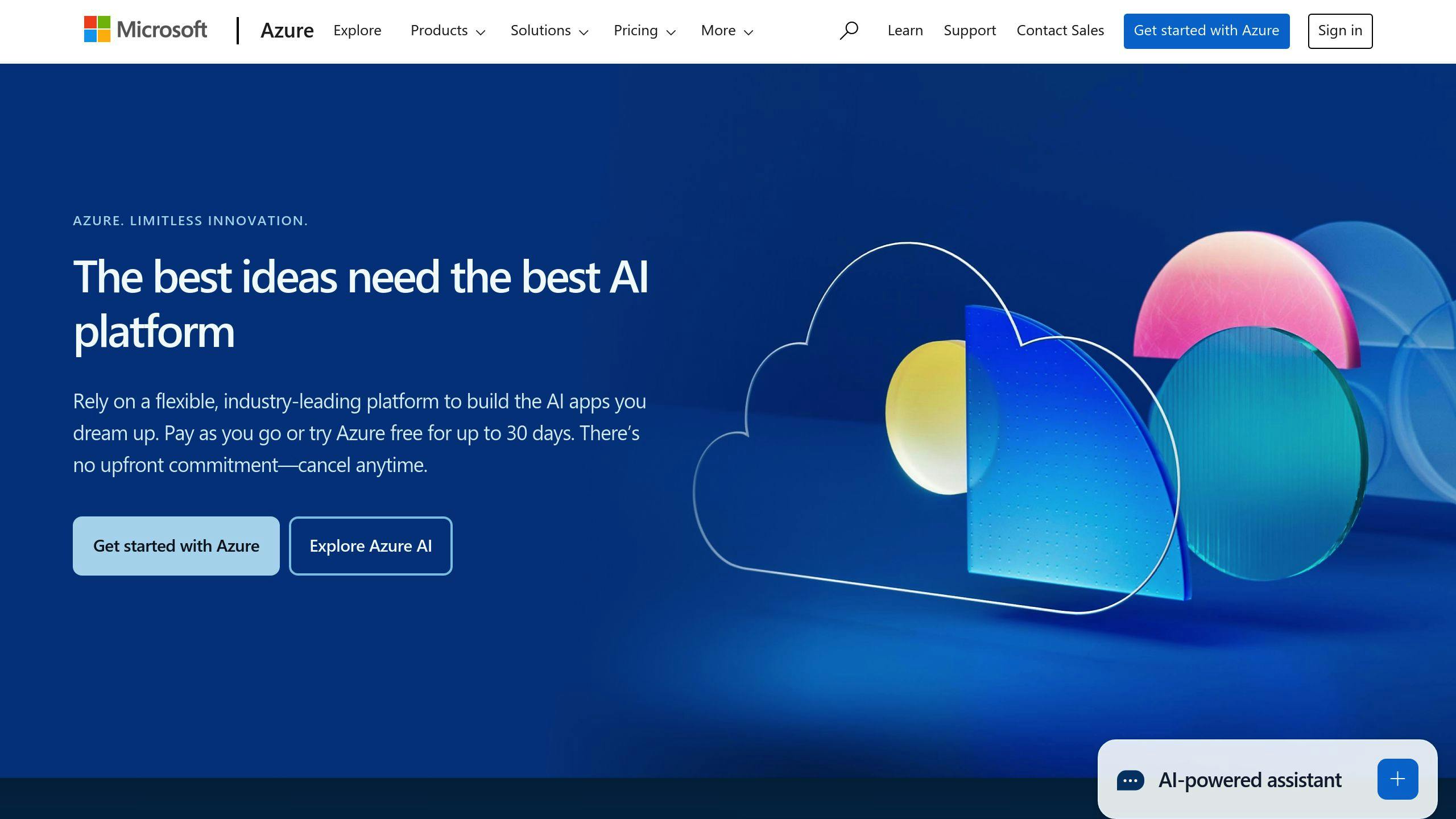
Azure is Microsoft's cloud platform with a bunch of PaaS services. Let's break it down:
What Can You Do?
- Build web apps
- Create mobile app backends
- Automate workflows
- Run serverless code
- Execute background tasks
Azure plays nice with .NET, Java, Node.js, PHP, and Python. It's got built-in security and stays up-to-date against threats.
What Languages Can You Use?
| Language | Where It Runs |
|---|---|
| .NET | Windows |
| .NET Core | Windows/Linux |
| Java | Windows/Linux |
| Node.js | Windows/Linux |
| PHP | Windows/Linux |
| Python | Windows/Linux |
| Ruby | Windows/Linux |
How Much Does It Cost?
Azure's got options for every wallet:
| Plan | Cores | RAM | Storage | Hourly Price |
|---|---|---|---|---|
| Free (F1) | Shared | 1 GB | 1 GB | $0 |
| Basic (B1) | 1 | 1.75 GB | 10 GB | $0.075 |
| Premium (P0v3) | 1 | 4 GB | 250 GB | $0.165 |
| Isolated (I1v2) | 2 | 8 GB | 1 TB | $0.562 |
New users get $200 to play with for 30 days. Not bad, right?
How Does It Scale?
You've got choices:
- Let Azure handle it
- Do it yourself
- Set up fancy rules
Here's a real-world example: Pearson VUE, a big testing company, switched to Azure in 2022. They cut costs by 30% and handled busy times better.
"Azure App Service let us focus on our actual work, not server stuff. It handled our busy times like a champ", said John Dahlin from Pearson VUE.
4. Engine Yard
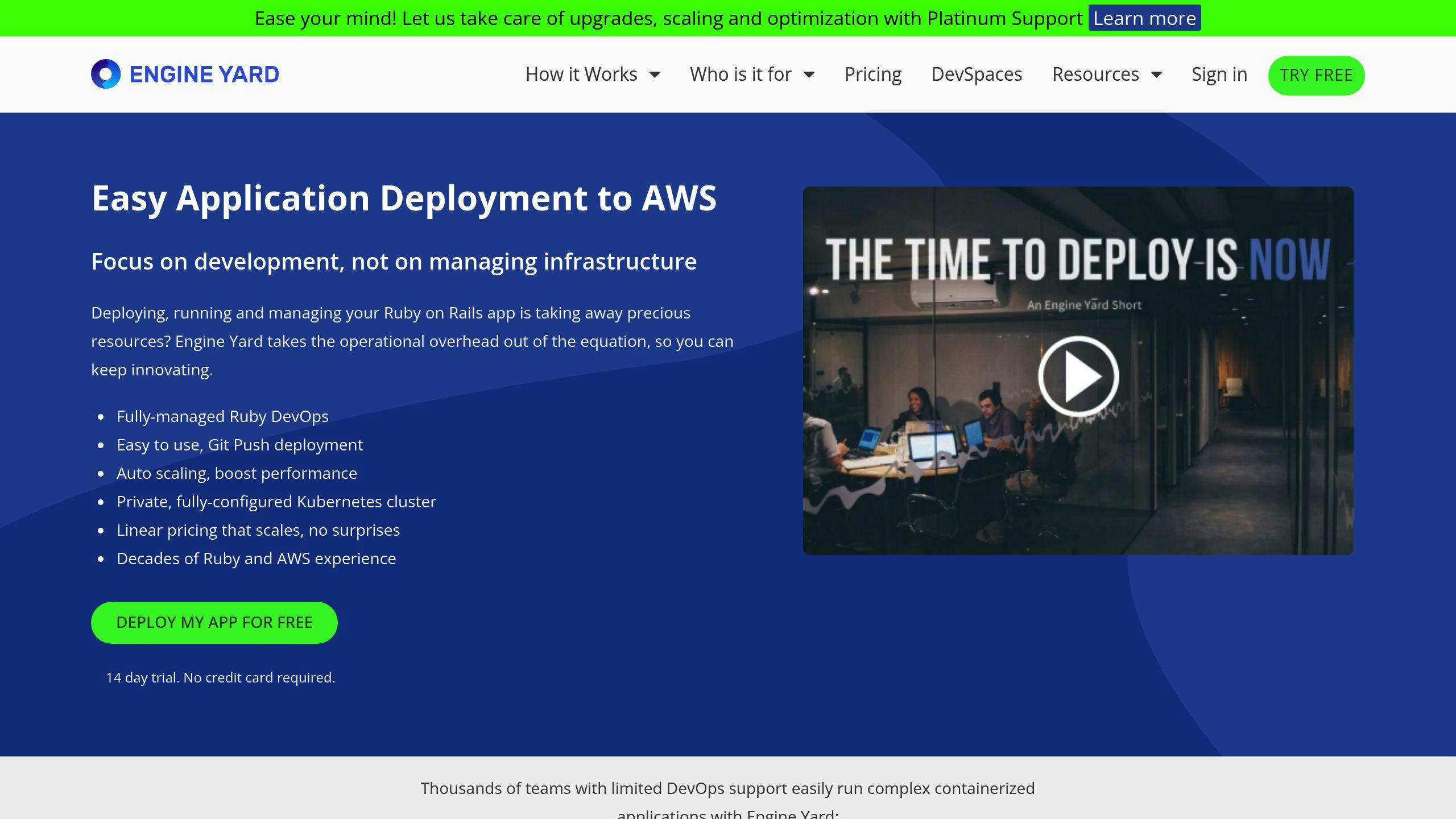
Engine Yard is a cloud platform for Ruby, PHP, and Node.js apps. It's all about giving you control while handling the heavy lifting.
What's Cool About It?
- You're the boss of your infrastructure
- MySQL and PostgreSQL databases with AWS S3 backups
- They promise zero downtime
- Your app grows automatically based on your rules
- SSH access to every machine (tweak away!)
What Can You Build With?
| Language | How Well It Works |
|---|---|
| Ruby on Rails | Like a charm |
| PHP | Smooth sailing |
| Node.js | No problem |
| Java | It's there, but not the star |
How Much Will It Cost You?
| Plan | Price | What You Get |
|---|---|---|
| Solo | $25/month/instance | Perfect for testing the waters |
| Standard | $150/month/instance | Most apps live here |
| Premium | $300/month/instance | Extra help when you need it |
| Platinum | $400/month/instance | Big guns (4+ servers, fancy DB support) |
Want containers? That's $49/month per optimized CPU, charged by the second.
Growing Pains? No Problem
Engine Yard's got your back:
- Set rules, and your app grows on its own
- Need more juice? Crank it up manually
- Clone your whole setup for testing
Back in 2011, Engine Yard's paying customers jumped 50% to 2,000. That's a lot of growing apps!
One happy user said: "At 3am, when your site's down and you're losing it, Engine Yard's still there, helping you through. That's when you get it."
If you want more control than Heroku but don't want to manage everything yourself, Engine Yard might be your sweet spot.
sbb-itb-61450c5
5. Heroku

Heroku is a cloud PaaS that lets developers build, run, and scale apps without infrastructure headaches.
Main Features
- Container-based "dynos" for easy scaling
- Git-based deployment
- Add-ons marketplace
- Salesforce integration
- OpEx module for troubleshooting
Languages Supported
Heroku supports 8 programming languages:
| Language | Support Level |
|---|---|
| Ruby | Full |
| Node.js | Full |
| Python | Full |
| Java | Full |
| PHP | Full |
| Go | Full |
| Scala | Full |
| Clojure | Full |
Pricing
Heroku's pricing is based on dyno types and app needs:
| Plan Type | Starting Price | Best For |
|---|---|---|
| Eco & Basic | $5/month | Testing ideas |
| Production | $25/month | Business apps |
| Advanced | $250/month | Mission-critical apps |
| Enterprise | Custom | Large-scale needs |
Dyno types and prices:
| Dyno Type | RAM | Price (max) |
|---|---|---|
| Eco | N/A | $5/month |
| Basic | N/A | $7/month |
| Standard 1X | 512 MB | $25/month |
| Standard 2X | 1 GB | $50/month |
| Performance M | 2.5 GB | $250/month |
| Performance L | 14 GB | $500/month |
Scaling Options
Heroku makes scaling a breeze:
- Add more dynos (horizontal scaling)
- Upgrade to larger dynos (vertical scaling)
- Autoscaling for Performance and Private dynos
"Heroku gives us the ideal infrastructure to support clients who are experiencing hypergrowth. Even when demand peaks, we just add more dynos and Heroku handles it seamlessly." - Dovetail
"Heroku makes it super easy for us to scale any number of device integrations individually. We can simply provision more dynos to handle increased traffic coming in from a specific device." - Yonomi
Heroku's pricing might be higher than some competitors, but many devs find its simplicity worth the cost.
6. IBM Cloud

IBM Cloud packs a punch with both PaaS and IaaS offerings. It's a solid player in the cloud game, even if it's not always in the spotlight like AWS, Azure, or Google Cloud.
What's in the Box?
IBM Cloud brings a lot to the table:
- Public, private, and hybrid cloud services
- AI and analytics tools
- Blockchain services
- Global data centers
- Hybrid cloud solutions
- Beefed-up security
Speak the Language
Java, Node.js, Python, Ruby - IBM Cloud speaks them all (and more). Got an existing app? No sweat. Moving it to the cloud is a breeze.
Show Me the Money
IBM Cloud keeps it flexible with pricing:
1. Pay-as-you-go
Use it, then pay for it. Simple as that.
2. Subscription
Commit to spending a certain amount, get a discount. Not bad, right?
3. Reserved capacity
Lock in for 1 or 3 years, pay less, billed monthly.
New to the party? Here's a $200 credit to play with for 30 days.
| Service | Starting Price |
|---|---|
| Bare metal servers | $158/month or $0.595/hour |
| Virtual servers | $0.038/hour or $25/month |
| GPU servers | $3.50/hour or $1,709/month |
| Object storage | $0.03/GB/month (first 500TB) |
Growing Pains?
No worries. IBM Cloud's got your back with migration options and DIY automation for scaling. Keep an eye on your progress with handy dashboards.
"The storage capabilities are awesome. IBM put a package together for us that made it affordable for a company of our size and that benefits our clients." - Happy Customer
IBM Cloud's got the goods, but heads up: some users say it can slow down during busy times. On the flip side, its security and customer support get two thumbs up.
7. Red Hat OpenShift
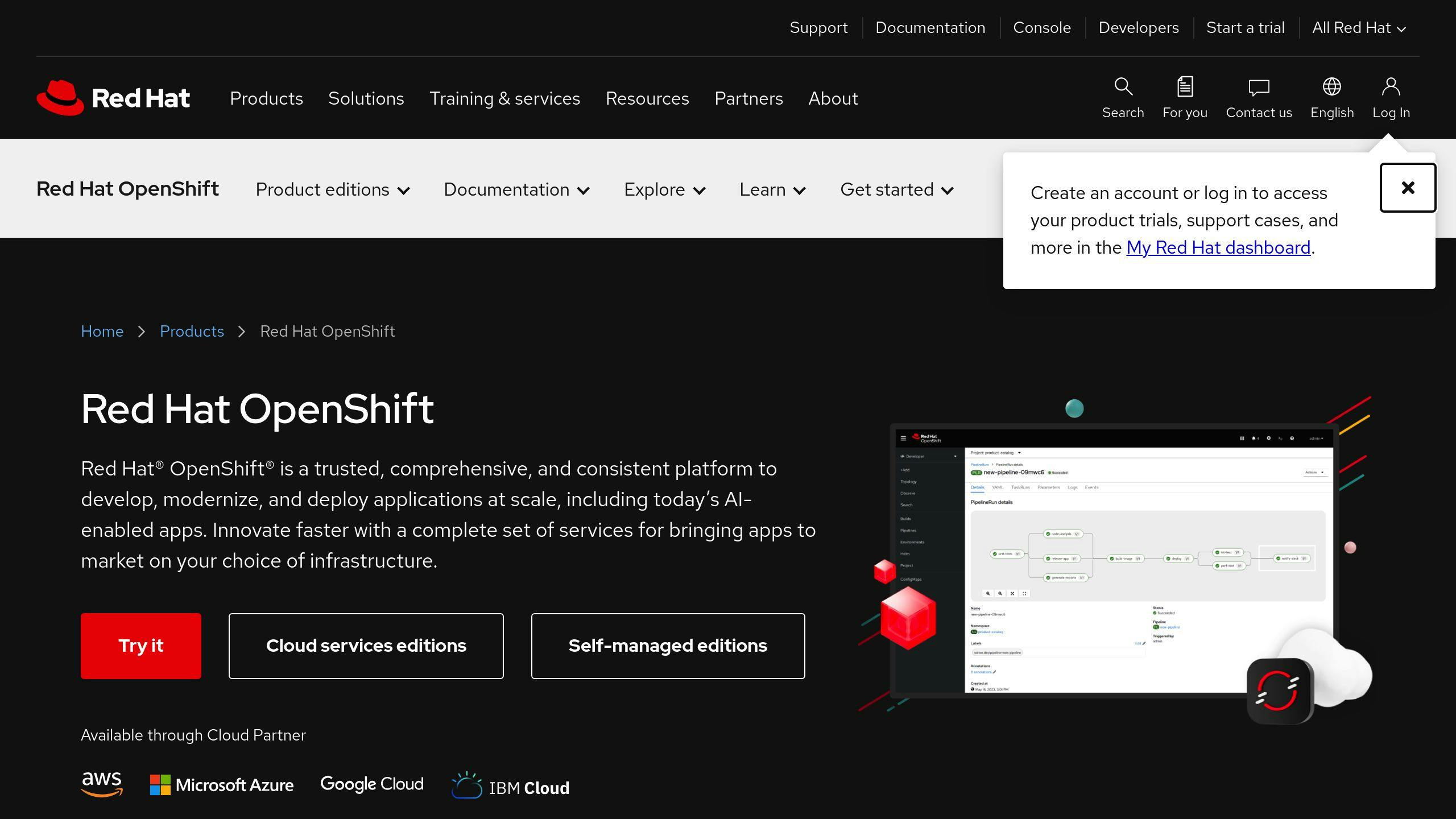
Red Hat OpenShift is a Kubernetes-based platform that makes it easy to deploy, manage, and scale containerized apps. Here's what you need to know:
Key Features
- Developer-friendly tools like Source-to-Image (S2I) and Developer Console
- Tight security with container scanning, role-based access, and auto-patching
- Works across multiple clouds
- Operator Framework for simpler app management
Supported Languages
OpenShift plays nice with:
Java, PHP, Ruby, Python, Node.js, Perl, and .NET Core
Pricing
OpenShift keeps it simple:
| Type | What You Get |
|---|---|
| Core-based | 2 Cores or 4 vCPUs |
| Socket-based | 2 Sockets (bare metal only) |
You pay based on hosts, not apps or memory. Choose Standard or Premium support.
Scaling
OpenShift's got your back:
- Cluster Autoscaler optimizes scaling based on your needs
- OpenShift Serverless (with Knative 1.11) auto-scales microservices and functions
- Self-managed Hosted Control Planes on AWS centralize management
The latest version, OpenShift 4.16, is built on Kubernetes 1.29 and CRI-O 1.29. It focuses on core improvements, better security, and features for telecom and edge computing. Even-numbered releases get a 3-year lifecycle, with an optional 12-month Extended Update Support.
Strengths and Weaknesses
Let's look at the pros and cons of top PaaS platforms to help you pick the right one for your business.
AWS Elastic Beanstalk
| Strengths | Weaknesses |
|---|---|
| 175+ services | EC2 limits |
| Unlimited servers | Security issues |
| Easy to use | Complex pricing |
Elastic Beanstalk supports Java, .NET, PHP, Node.js, Python, Ruby, Go, and Docker. It's a top pick for many due to its ease of use and diverse tools.
Microsoft Azure
| Strengths | Weaknesses |
|---|---|
| Strong security | Needs expertise |
| Cost-effective | Management overhead |
| App-friendly | Migration challenges |
| Highly scalable |
Azure's Microsoft integration and enterprise focus make it popular with large organizations.
Google Cloud Platform
| Strengths | Weaknesses |
|---|---|
| G-Suite integration | Poor docs |
| AI insights | Needs management |
| High security | Smaller market share |
| Pay-per-second billing |
Google Cloud's billing can save money compared to AWS and Azure, especially for fluctuating workloads.
Engine Yard
| Strengths | Weaknesses |
|---|---|
| Ruby on Rails focus | Limited languages |
| Auto scaling | Higher starting price |
| Managed DevOps | Fewer tools |
Engine Yard's Ruby on Rails specialty makes it niche, but its managed platform can help teams offload DevOps work.
Heroku
| Strengths | Weaknesses |
|---|---|
| Container-based (dynos) | Pricey at scale |
| Many add-ons | Limited control |
| GitHub integration | Potential lock-in |
Heroku's containers and add-ons make it popular with startups and for quick prototyping.
IBM Cloud
| Strengths | Weaknesses |
|---|---|
| Hybrid options | Complex for newbies |
| Enterprise focus | Higher starting price |
| AI and analytics | Smaller ecosystem |
IBM Cloud's enterprise-grade solutions and hybrid focus suit large organizations with complex needs.
Red Hat OpenShift
| Strengths | Weaknesses |
|---|---|
| Kubernetes-based | Steep learning curve |
| Multi-cloud support | Resource-heavy |
| Strong security | Can be expensive |
OpenShift's Kubernetes base and multi-cloud support make it great for standardizing container orchestration across environments.
When picking a PaaS, think about your needs, budget, and tech skills. Each platform has trade-offs, so what's best for one company might not work for another.
For example, if you're a startup focused on fast development and don't want to manage infrastructure, Heroku might be your best bet. But if you're a big enterprise with Microsoft investments, Azure could offer the smoothest integration.
Summary
The PaaS market is booming. It's set to hit $176 billion by 2024. This growth means picking the right platform is crucial. Here's a quick rundown:
| Platform | Best For | Key Feature |
|---|---|---|
| AWS Elastic Beanstalk | Language variety | 175+ services |
| Microsoft Azure | Enterprise | Strong security |
| Google App Engine | Serverless | AI insights |
| Engine Yard | Ruby on Rails | Managed DevOps |
| Heroku | Startups | Container-based |
| IBM Cloud | Large orgs | Hybrid options |
| Red Hat OpenShift | Multi-cloud | Kubernetes-based |
Each platform has its pros and cons:
- AWS Elastic Beanstalk: Lots of services, but pricing can be tricky.
- Microsoft Azure: Secure, but needs expertise.
- Google App Engine: Great with G-Suite, smaller market share.
- Engine Yard: Ruby on Rails pro, fewer language options.
- Heroku: Easy to use, pricey as you grow.
- IBM Cloud: Enterprise-focused, might confuse newbies.
- Red Hat OpenShift: Multi-cloud support, steep learning curve.
When choosing a PaaS, think about:
- What your app needs
- Your budget
- How much you might grow
- Support quality
- Security must-haves
- Room for innovation
For instance, if you're a startup wanting to move fast, Heroku could be your best bet. Its container system and GitHub link can speed things up. But if you're a big company already using Microsoft stuff, Azure might fit better with what you've got.
FAQs
What factors should be considered when selecting a cloud vendor or provider?
Choosing a cloud vendor isn't a one-size-fits-all deal. Here's what you need to look at:
1. Certifications & Standards
Does the provider have the right certs? This shows they're following the rules and best practices.
2. Technologies & Service Roadmap
What can they do now, and what's coming up? Make sure they can keep up with your needs.
3. Data Security & Governance
How do they keep your data safe? This is BIG, especially if you're dealing with sensitive info.
4. Service Dependencies & Partnerships
How do their services play with others? Who are they partnered with?
5. Contracts, Commercials & SLAs
Read the fine print. Know what you're getting into with pricing and service agreements.
6. Reliability & Performance
How often are they up? How fast are they? Numbers don't lie.
Here's a quick look at our top 7 PaaS platforms:
| Platform | Key Certification | Standout Feature | Data Security |
|---|---|---|---|
| AWS Elastic Beanstalk | ISO 27001 | 175+ services | AWS Shield |
| Microsoft Azure | SOC 2 Type II | Strong enterprise integration | Azure Security Center |
| Google App Engine | ISO/IEC 27001:2013 | AI-powered insights | Google Cloud Armor |
| Engine Yard | PCI DSS | Managed DevOps | Encrypted data at rest |
| Heroku | SOC 2 Type II | Easy deployment | SSL/TLS encryption |
| IBM Cloud | HIPAA | Hybrid cloud options | IBM Cloud Crypto Services |
| Red Hat OpenShift | FedRAMP | Kubernetes-based | Red Hat Advanced Cluster Security |
Your best pick? It depends on what you need. Handling health data? IBM Cloud's HIPAA compliance might be your thing. Want easy deployment? Heroku's got you covered.
Don't forget about your wallet and growth plans. Heroku can get pricey as you grow, while AWS gives you more wiggle room with pricing.